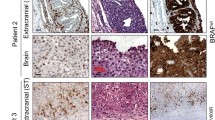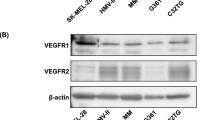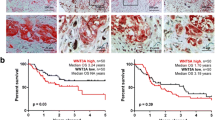Abstract
Purpose
Melanoma tumors are highly heterogeneous and can undergo phenotypic modifications depending on their plasticity and the microenvironment, with shifts between proliferative and invasive states. We have shown that melanoma cells, grown as spheroids in a neural crest cell medium, polarize toward an invasive and motile phenotype, in agreement with transcriptomic modulations, including the up-regulation of Nanog and Oct4. Overexpression of these genes was shown to be associated with poor prognosis and metastatic forms of some cancers. We thus investigated implication of Nanog and Oct4, two embryonic transcription factors, in melanoma motility.
Methods
Our team used stable transfection of Nanog or Oct4 in A375 melanoma cell line to investigate motility in a wound healing assay and a transendothelial migration assay. Using semiquantitative RT-PCR, expression of two gene panels involved either in mesenchymal motility or in amoeboid migration was studied.
Results
Strongly enhanced capacities of motility and extravasation were observed with cells overexpressing Oct4 and Nanog. The A375 cell line has been described as having a mesenchymal migration type. However, in the Oct4 and Nanog transfectants, several amoeboid migration markers are strongly induced. Accordingly, amoeboid migration inhibitors decrease significantly the transmigration of Oct4- and Nanog-expressing cells through endothelial cells.
Conclusions
We propose here that Nanog and Oct4 pluripotency marker expression in melanoma cells increases the transmigration capacity of these cells through the gain of amoeboid motility, leading to higher invasiveness and aggressiveness.




Similar content being viewed by others
References
Belgiovine C, Frapolli R, Bonezzi K, Chiodi I, Favero F, Mello-Grand M, Dei Tos AP, Giulotto E, Taraboletti G, D’Incalci M, Mondello C (2010) Reduced expression of the ROCK inhibitor Rnd3 is associated with increased invasiveness and metastatic potential in mesenchymal tumor cells. PLoS One 5(11):e14154. doi:10.1371/journal.pone.0014154
Bhatia S, Tykodi SS, Thompson JA (2009) Treatment of metastatic melanoma: an overview. Oncology (Williston Park) 23(6):488–496
Chang CC, Shieh GS, Wu P, Lin CC, Shiau AL, Wu CL (2008) Oct-3/4 expression reflects tumor progression and regulates motility of bladder cancer cells. Cancer Res 68(15):6281–6291. doi:10.1158/0008-5472.CAN-08-0094
Cheli Y, Giuliano S, Botton T, Rocchi S, Hofman V, Hofman P, Bahadoran P, Bertolotto C, Ballotti R (2011) Mitf is the key molecular switch between mouse or human melanoma initiating cells and their differentiated progeny. Oncogene 30(20):2307–2318. doi:10.1038/onc.2010.598
Chiou SH, Wang ML, Chou YT, Chen CJ, Hong CF, Hsieh WJ, Chang HT, Chen YS, Lin TW, Hsu HS, Wu CW (2010) Coexpression of Oct4 and Nanog enhances malignancy in lung adenocarcinoma by inducing cancer stem cell-like properties and epithelial-mesenchymal transdifferentiation. Cancer Res 70(24):10433–10444. doi:10.1158/0008-5472.CAN-10-2638
Cicchini C, Laudadio I, Citarella F, Corazzari M, Steindler C, Conigliaro A, Fantoni A, Amicone L, Tripodi M (2008) TGFbeta-induced EMT requires focal adhesion kinase (FAK) signaling. Exp Cell Res 314(1):143–152. doi:10.1016/j.yexcr.2007.09.005
Clark EA, Golub TR, Lander ES, Hynes RO (2000) Genomic analysis of metastasis reveals an essential role for RhoC. Nature 406(6795):532–535. doi:10.1038/35020106
Du Z, Jia D, Liu S, Wang F, Li G, Zhang Y, Cao X, Ling EA, Hao A (2009) Oct4 is expressed in human gliomas and promotes colony formation in glioma cells. Glia 57(7):724–733. doi:10.1002/glia.20800
Fluge O, Bruland O, Akslen LA, Lillehaug JR, Varhaug JE (2006) Gene expression in poorly differentiated papillary thyroid carcinomas. Thyroid 16(2):161–175
Gadea G, Sanz-Moreno V, Self A, Godi A, Marshall CJ (2008) DOCK10-mediated Cdc42 activation is necessary for amoeboid invasion of melanoma cells. Curr Biol 18(19):1456–1465. doi:10.1016/j.cub.2008.08.053
Ghislin S, Obino D, Middendorp S, Boggetto N, Alcaide-Loridan C, Deshayes F (2011) Junctional adhesion molecules are required for melanoma cell lines transendothelial migration in vitro. Pigment Cell Melanoma Res 24(3):504–511. doi:10.1111/j.1755-148X.2011.00856.x
Ghislin S, Deshayes F, Lauriol J, Middendorp S, Martins I, Al-Daccak R, Alcaide-Loridan C (in press) Plasticity of melanoma cells induced by neural cell crest conditions and three-dimensional growth. Melanoma Res
Ghosh S, Spagnoli GC, Martin I, Ploegert S, Demougin P, Heberer M, Reschner A (2005) Three-dimensional culture of melanoma cells profoundly affects gene expression profile: a high density oligonucleotide array study. J Cell Physiol 204(2):522–531. doi:10.1002/jcp.20320
Haqq C, Nosrati M, Sudilovsky D, Crothers J, Khodabakhsh D, Pulliam BL, Federman S, Miller JR 3rd, Allen RE, Singer MI, Leong SP, Ljung BM, Sagebiel RW, Kashani-Sabet M (2005) The gene expression signatures of melanoma progression. Proc Natl Acad Sci USA 102(17):6092–6097. doi:10.1073/pnas.0501564102
Hoek KS, Schlegel NC, Brafford P, Sucker A, Ugurel S, Kumar R, Weber BL, Nathanson KL, Phillips DJ, Herlyn M, Schadendorf D, Dummer R (2006) Metastatic potential of melanomas defined by specific gene expression profiles with no BRAF signature. Pigment Cell Res 19(4):290–302. doi:10.1111/j.1600-0749.2006.00322.x
Hoek KS, Eichhoff OM, Schlegel NC, Dobbeling U, Kobert N, Schaerer L, Hemmi S, Dummer R (2008) In vivo switching of human melanoma cells between proliferative and invasive states. Cancer Res 68(3):650–656. doi:10.1158/0008-5472.CAN-07-2491
Jeffs AR, Glover AC, Slobbe LJ, Wang L, He S, Hazlett JA, Awasthi A, Woolley AG, Marshall ES, Joseph WR, Print CG, Baguley BC, Eccles MR (2009) A gene expression signature of invasive potential in metastatic melanoma cells. PLoS One 4(12):e8461. doi:10.1371/journal.pone.0008461
Jemal A, Siegel R, Xu J, Ward E (2010) Cancer statistics, 2010. CA Cancer J Clin 60(5):277–300. doi:10.3322/caac.20073
Jeter CR, Badeaux M, Choy G, Chandra D, Patrawala L, Liu C, Calhoun-Davis T, Zaehres H, Daley GQ, Tang DG (2009) Functional evidence that the self-renewal gene Nanog regulates human tumor development. Stem Cells 27(5):993–1005. doi:10.1002/stem.29
Kashyap V, Rezende NC, Scotland KB, Shaffer SM, Persson JL, Gudas LJ, Mongan NP (2009) Regulation of stem cell pluripotency and differentiation involves a mutual regulatory circuit of the Nanog, Oct4, and Sox2 pluripotency transcription factors with polycomb repressive complexes and stem cell microRNAs. Stem Cells Dev 18(7):1093–1108. doi:10.1089/scd.2009.0113
Kinch MS, Carles-Kinch K (2003) Overexpression and functional alterations of the EphA2 tyrosine kinase in cancer. Clin Exp Metastasis 20(1):59–68
Livak KJ, Schmittgen TD (2001) Analysis of relative gene expression data using real-time quantitative PCR and the 2(-Delta Delta C(T)) method. Methods 25(4):402–408. doi:10.1006/meth.2001.1262
Martins I, Sylla K, Deshayes F, Lauriol J, Ghislin S, Dieu-Nosjean MC, Viguier M, Verola O, Charron D, Alcaide-Loridan C, Al-Daccak R (2009) Coexpression of major histocompatibility complex class II with chemokines and nuclear NFkappaB p50 in melanoma: a rational for their association with poor prognosis. Melanoma Res 19(4):226–237. doi:10.1097/CMR.0b013e32832e0bc3
Pankova K, Rosel D, Novotny M, Brabek J (2010) The molecular mechanisms of transition between mesenchymal and amoeboid invasiveness in tumor cells. Cell Mol Life Sci 67(1):63–71. doi:10.1007/s00018-009-0132-1
Parri M, Taddei ML, Bianchini F, Calorini L, Chiarugi P (2009) EphA2 reexpression prompts invasion of melanoma cells shifting from mesenchymal to amoeboid-like motility style. Cancer Res 69(5):2072–2081. doi:10.1158/0008-5472.CAN-08-1845
Perego M, Tortoreto M, Tragni G, Mariani L, Deho P, Carbone A, Santinami M, Patuzzo R, Mina PD, Villa A, Pratesi G, Cossa G, Perego P, Daidone MG, Alison MR, Parmiani G, Rivoltini L, Castelli C (2010) Heterogeneous phenotype of human melanoma cells with in vitro and in vivo features of tumor-initiating cells. J Invest Dermatol 130(7):1877–1886. doi:10.1038/jid.2010.69
Pinner S, Sahai E (2008) PDK1 regulates cancer cell motility by antagonising inhibition of ROCK1 by RhoE. Nat Cell Biol 10(2):127–137. doi:10.1038/ncb1675
Ramgolam K, Lauriol J, Lalou C, Lauden L, Michel L, de la Grange P, Khatib AM, Aoudjit F, Charron D, Alcaide-Loridan C, Al-Daccak R (2011) Melanoma spheroids grown under neural crest cell conditions are highly plastic migratory/invasive tumor cells endowed with immunomodulator function. PLoS One 6(4):e18784. doi:10.1371/journal.pone.0018784
Sahai E, Garcia-Medina R, Pouyssegur J, Vial E (2007) Smurf1 regulates tumor cell plasticity and motility through degradation of RhoA leading to localized inhibition of contractility. J Cell Biol 176(1):35–42. doi:10.1083/jcb.200605135
Sakamoto S, McCann RO, Dhir R, Kyprianou N (2010) Talin1 promotes tumor invasion and metastasis via focal adhesion signaling and anoikis resistance. Cancer Res 70(5):1885–1895. doi:10.1158/0008-5472.CAN-09-2833
Sanz-Moreno V, Gadea G, Ahn J, Paterson H, Marra P, Pinner S, Sahai E, Marshall CJ (2008) Rac activation and inactivation control plasticity of tumor cell movement. Cell 135(3):510–523. doi:10.1016/j.cell.2008.09.043
Siu MK, Wong ES, Chan HY, Ngan HY, Chan KY, Cheung AN (2008) Overexpression of NANOG in gestational trophoblastic diseases: effect on apoptosis, cell invasion, and clinical outcome. Am J Pathol 173(4):1165–1172. doi:10.2353/ajpath.2008.080288
Tan TK, Zheng G, Hsu TT, Wang Y, Lee VW, Tian X, Cao Q, Harris DC (2010) Macrophage matrix metalloproteinase-9 mediates epithelial-mesenchymal transition in vitro in murine renal tubular cells. Am J Pathol 176(3):1256–1270. doi:10.2353/ajpath.2010.090188
Tumbarello DA, Brown MC, Hetey SE, Turner CE (2005) Regulation of paxillin family members during epithelial-mesenchymal transformation: a putative role for paxillin delta. J Cell Sci 118(Pt 20):4849–4863. doi:10.1242/jcs.02615
Wang HR, Zhang Y, Ozdamar B, Ogunjimi AA, Alexandrova E, Thomsen GH, Wrana JL (2003) Regulation of cell polarity and protrusion formation by targeting RhoA for degradation. Science 302(5651):1775–1779. doi:10.1126/science.1090772
Wen J, Park JY, Park KH, Chung HW, Bang S, Park SW, Song SY (2010) Oct4 and Nanog expression is associated with early stages of pancreatic carcinogenesis. Pancreas 39(5):622–626. doi:10.1097/MPA.0b013e3181c75f5e
Wolf K, Mazo I, Leung H, Engelke K, von Andrian UH, Deryugina EI, Strongin AY, Brocker EB, Friedl P (2003) Compensation mechanism in tumor cell migration: mesenchymal-amoeboid transition after blocking of pericellular proteolysis. J Cell Biol 160(2):267–277. doi:10.1083/jcb.200209006
Yilmaz M, Christofori G (2010) Mechanisms of motility in metastasizing cells. Mol Cancer Res 8(5):629–642. doi:10.1158/1541-7786.MCR-10-0139
Acknowledgments
The authors wish to thank Benoit Souchet and Nadim Kassis for their technical assistance.
Conflict of interest
We declare that we have no conflict of interest.
Author information
Authors and Affiliations
Corresponding author
Rights and permissions
About this article
Cite this article
Borrull, A., Ghislin, S., Deshayes, F. et al. Nanog and Oct4 overexpression increases motility and transmigration of melanoma cells. J Cancer Res Clin Oncol 138, 1145–1154 (2012). https://doi.org/10.1007/s00432-012-1186-2
Received:
Accepted:
Published:
Issue Date:
DOI: https://doi.org/10.1007/s00432-012-1186-2




